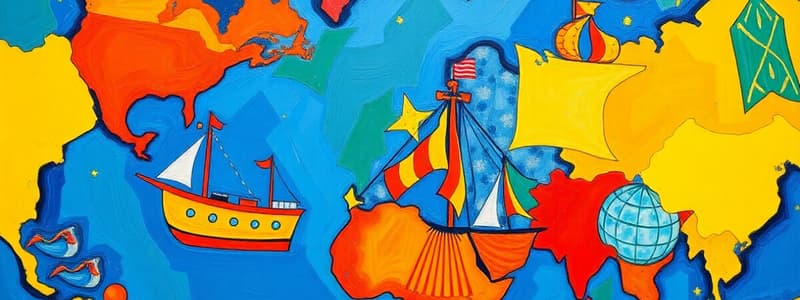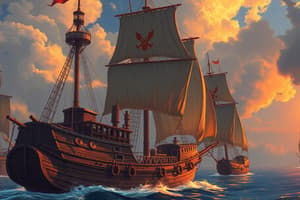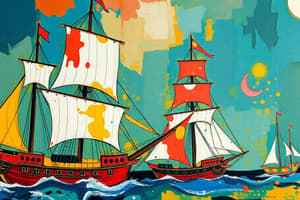Podcast
Questions and Answers
What economic strategies did maritime empires use to increase their power?
What economic strategies did maritime empires use to increase their power?
Maritime empires used economic strategies designed to sell as many goods as they could to other countries in order to obtain maximum amounts of gold and silver. They also tried to spend as little of their precious metals as possible on goods from other countries.
What were the keys to the development of mercantilist empires?
What were the keys to the development of mercantilist empires?
- Silver
- Sugar
- Slavery
- All of the above (correct)
What is capital?
What is capital?
Material wealth available to produce more wealth.
The transformation to a trade-based economy using gold and silver is known as what?
The transformation to a trade-based economy using gold and silver is known as what?
The high rate of inflation in the 16th and early 17th century is called what?
The high rate of inflation in the 16th and early 17th century is called what?
Joint-stock companies are owned by investors who bought stock or shares in them.
Joint-stock companies are owned by investors who bought stock or shares in them.
What is limited liability?
What is limited liability?
Which countries developed joint-stock companies in the 17th century?
Which countries developed joint-stock companies in the 17th century?
Where was the first stock exchange?
Where was the first stock exchange?
Voyages in the Atlantic had three segments and were called what?
Voyages in the Atlantic had three segments and were called what?
What was the most profitable good from the Americas?
What was the most profitable good from the Americas?
Monopolies granted certain merchants what?
Monopolies granted certain merchants what?
What did the Atlantic slave trade cause in Africa?
What did the Atlantic slave trade cause in Africa?
The taking of more than one wife is called what?
The taking of more than one wife is called what?
Spanish royalty appointed what to act as administrators and representatives of the Spanish crown?
Spanish royalty appointed what to act as administrators and representatives of the Spanish crown?
What does Santéria mean?
What does Santéria mean?
What does Vodun mean?
What does Vodun mean?
What does Candomblé mean?
What does Candomblé mean?
Flashcards
Maritime Empires
Maritime Empires
Sea-based empires that transformed trade from local barter to large-scale international trade using gold and silver.
Joint-Stock Companies
Joint-Stock Companies
Economic model where investors finance trade by buying shares in companies, like the East India Company.
Wealth Measurement (17th Century)
Wealth Measurement (17th Century)
An economic strategy where countries maximize gold and silver by exporting more than they import.
Capital
Capital
Signup and view all the flashcards
Commercial Revolution
Commercial Revolution
Signup and view all the flashcards
Price Revolution
Price Revolution
Signup and view all the flashcards
Limited Liability
Limited Liability
Signup and view all the flashcards
Dutch Commercial Middlemen
Dutch Commercial Middlemen
Signup and view all the flashcards
Financial Bubbles
Financial Bubbles
Signup and view all the flashcards
Triangular Trade
Triangular Trade
Signup and view all the flashcards
Monopolies
Monopolies
Signup and view all the flashcards
Effects of Slave Trade
Effects of Slave Trade
Signup and view all the flashcards
Slave-Raiding Kingdoms
Slave-Raiding Kingdoms
Signup and view all the flashcards
Polygyny
Polygyny
Signup and view all the flashcards
Impact of New Foods (Africa)
Impact of New Foods (Africa)
Signup and view all the flashcards
Viceroy
Viceroy
Signup and view all the flashcards
Audiencias
Audiencias
Signup and view all the flashcards
Creoles
Creoles
Signup and view all the flashcards
Syncretism
Syncretism
Signup and view all the flashcards
Santería
Santería
Signup and view all the flashcards
Vodun
Vodun
Signup and view all the flashcards
Candomblé
Candomblé
Signup and view all the flashcards
African American Church
African American Church
Signup and view all the flashcards
Virgin of Guadelupe
Virgin of Guadelupe
Signup and view all the flashcards
Voyages
Voyages
Signup and view all the flashcards
Indian Ocean Trade Rivalries
Indian Ocean Trade Rivalries
Signup and view all the flashcards
Trade Patterns
Trade Patterns
Signup and view all the flashcards
Latin America Political Structures
Latin America Political Structures
Signup and view all the flashcards
Religion
Religion
Signup and view all the flashcards
Land based empire Traditions
Land based empire Traditions
Signup and view all the flashcards
Study Notes
- Maritime empires transformed commerce from small-scale trading to large-scale international trade using gold and silver.
- These empires utilized new economic models like joint-stock companies.
- Investors financed trade by buying shares in companies like the East India Company, boosting trade in Asia.
- New ocean trade routes expanded the global economy.
- The Atlantic trading system involved the movement of labor, including enslaved people, and the mixing of cultures, resulting in cultural synthesis.
- Silver, sugar, and slavery were crucial to the development of mercantilist empires.
Economic Strategies
- In the 17th century, European countries measured wealth by the amount of gold and silver they possessed.
- Countries aimed to sell as many goods as possible to acquire gold and silver and minimize spending on foreign goods.
- Capital accumulation in Western Europe grew as entrepreneurs engaged in long-distance markets.
- Capital shifted from entrepreneurs to laborers, improving laborers' positions as consumers and investors.
- Lending money at high interest rates became common, despite Church restrictions.
- Actual wealth increased with the influx of gold and silver from the Western Hemisphere.
Commercial Revolution
- The shift to a trade-based economy using gold and silver is known as the Commercial Revolution.
- The Commercial Revolution was influenced by:
- Development of overseas colonies
- New ocean trade routes
- Population growth
- Inflation
- High inflation in the 16th-early 17th century is referred to as the Price Revolution.
- Joint-stock companies, owned by investors, facilitated the growth of the global economy.
- Investors shared profits and risks in exploration and trade ventures, with limited liability making investing safer.
- The European middle class invested in their own countries' businesses and purchased imported luxuries.
- The Dutch, English, and French developed joint-stock companies in the 17th century, including the British East India Company (1600) and the Dutch East India Company (1602).
- Spain and Portugal primarily invested through government grants to explorers.
- Joint-stock companies drove maritime empire development by enabling continued exploration, colonization, and resource development with reduced investor risk.
- The Dutch acted as commercial middlemen, establishing trade routes to Latin America, North America, South Africa, and Indonesia.
- Dutch ships were faster, providing a trade advantage.
- The Dutch East India Company thrived as a joint-stock company, earning significant profits in the Spice Islands and Southeast Asia.
- The Dutch had a stock exchange by 1602 and the Bank of Amsterdam traded currency internationally by 1609.
- The Dutch enjoyed the highest standard of living in Europe, with goods like diamonds and tulip bulbs traded by Dutch merchants.
- France and England experienced speculative financial schemes called financial bubbles in the 18th century.
- These schemes involved selling shares with promised returns, leading to a frenzy of buying that eventually burst, causing financial ruin for investors.
Triangular Trade
- European demand for enslaved workers in the Americas, coupled with Portugal's exploration of West Africa, made Africa a labor source.
- Enslaved Africans became part of the triangular trade system, involving three segments.:
- European manufactured goods (firearms) to West Africa
- Enslaved Africans to the Americas
- Sugar or tobacco from the Americas to Europe
- Sugar was the most profitable product from the Americas.
- By the 1700s, Caribbean sugar and rum production financed fortunes in Britain, France, and the Netherlands.
Rivalries for the Indian Ocean Trade
- After Europeans discovered the Americas, Atlantic Ocean trade became important.
- States still competed for control of Indian Ocean trade routes.
- The Portuguese defeated a Muslim and Venetian force in 1509 to control trade in the Arabian Sea.
- In 1578, the Portuguese were defeated by Moroccan forces in a battle on land.
- Morocco captured the riches of the Songhai Kingdom in 1590 despite a prohibition against warring with other Muslim states.
- Moroccan forces overcame the Songhai near Gao using firearms, leading to the empire's collapse.
- The Spanish and Portuguese soon overtook much of the territory.
Change and Continuities in Trade Networks
- Trading networks resulted in a new global distribution of goods, wealth, and labor.
- Silver from Spanish colonies flowed to Asia, where it was exchanged for goods like silks and porcelain.
- Asian goods were in demand in Atlantic markets.
- Monopolies, chartered by European rulers, maintained trade patterns.
- These monopolies granted exclusive trading rights to certain merchants (often joint-stock companies) or the government.
- The Spanish government monopolized domestic tobacco and later tobacco from American colonies, enriching itself.
- Tobacco income constituted about one-third of Spain's total revenues.
- Traditional regional markets in Afro-Eurasia persisted alongside global trade.
- Improved shipping allowed merchants to increase product volumes.
- Increased peasant and artisan labor output (wool, linen, cotton, silk) was exchanged in global port cities.
Effects of the Atlantic Slave Trade
- The Atlantic slave trade significantly weakened West African kingdoms like Kongo.
- Population growth slowed due to the loss of people.
- Trade competition led to violence and made African kingdoms dependent on European goods.
- Such societies developed complex economies slowly, setting the stage for European conquest and imperialism in the late 19th century.
- African societies like Dahomey and Oyo grew richer by selling captives to Europeans.
- Societies that exchanged enslaved people for firearms gained an advantage over those without them.
- Raiding societies became richer and more fortified with firearms.
- Intergroup warfare increased in frequency and intensity due to the slave trade.
- The slave trade heavily affected West African populations in present-day Ghana and Benin.
- Gender distributions became imbalanced, with more than two-thirds of enslaved individuals being male, leading to increased polygyny and women taking on traditionally male roles.
- The Atlantic trading system spurred population growth in Africa through improved diets with crops like maize and manioc.
Political and Cultural Changes for Indigenous People
- European empires in the Americas contrasted with earlier land-based empires in their treatment of conquered people.
- Spanish and Portuguese empires erased basic social structures and many cultural traditions of indigenous Americans within a century of European arrival, leading to depopulation.
- Indigenous political structures in Latin America were replaced by Spanish and Portuguese administrations.
- Spanish royalty appointed viceroys and also the audiencias to keep them from operating independently of the crown.
- Due to slow communication, the Spanish crown didn't focus on colonial affairs in the Western Hemisphere.
- Indigenous peoples lost much of their culture and history.
- Conquistadors burned native books, leaving few original accounts.
Effects of Belief Systems
- The increase in global connections extended the reach of existing religions, contributed to syncretic belief systems, and religious conflicts.
- Cultural syncretism developed, combining religious beliefs and practices.
Syncretic Belief Systems in the Americas
- African religions in the Americas combine religious beliefs and practices:
- Santería: a African faith that means "the way of the saints." which became common in CUba and LAtin America and North America. -Vodun: a belief system means "spirit" or "deity" that began with African peoples of Dahomey, Kongo, and Yoruba who became enslaved and living in Saint-Domingue, which is now Haiti. -Candomblé: a combination of Yoruba, Fon, and Bantu beliefs, originating in different areas of Africa that means “dance to honor the gods" developed in Brazil.
- Enslaved Africans in the United States established the African American church, blending Christianity and African spiritual traditions.
- About 1 in 10 enslaved Africans practiced Islam, establishing the first significant presence of Islam in the Americas.
- Catholic religious orders sent missionaries to Latin America to convert people to Christianity.
- Religious syncretism originated in Spanish colonies, with Catholic saints' days coinciding with indigenous celebrations.
- In Mexico, the Virgin of Guadalupe became a cult figure, revered for her ability to perform miracles.
- Akbar attempted to reduce religius conflicts between Muslims and Hindus.
Studying That Suits You
Use AI to generate personalized quizzes and flashcards to suit your learning preferences.
Related Documents
Description
The rise of maritime empires transformed commerce, utilizing gold, silver, and joint-stock companies. The Atlantic trading system led to cultural synthesis. Silver, sugar, and slavery were crucial for mercantilist empires and capital accumulation in Western Europe.




